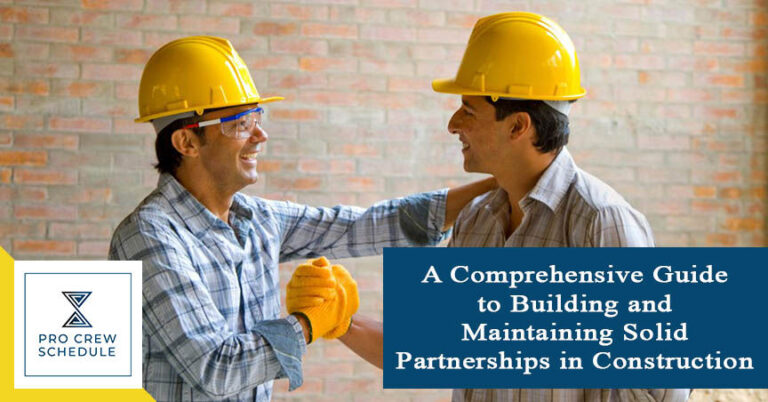When managing construction, you will find yourself working with many people. From clients, suppliers, and subcontractors to trade partners and stakeholders, building strong partnerships that focus on constant communication and smooth collaboration is critical. Partnerships are essential to ensure a seamless project delivery and a stress-free, enjoyable experience for everyone. These partnerships can be anything from joint projects to strategic alliances.
A partnership is a two-way relationship from which both parties should benefit. When you form a partnership, you and your partners can gain access to each other’s knowledge, resources, and industry contacts.
However, managing these relationships is easier said than done. It is critical to create a sound partnership management system and pay close attention to it. This article will discuss the essential parts of a good partnership, its benefits, tips on how to build and manage solid relationships, and some of the common challenges you may encounter.
Why is Partner Management Important?
Partner management allows you to monitor the relationships between the two parties closely. It focuses on finding ways to work together, share resources, communicate, and collaborate to reach common goals.
Businesses can offer more goods and services by combining resources, skills, and knowledge. For example, a plumbing contractor provides the proper knowledge, experience, and specialized skills to perform a specific task. This ensures that each project is completed with the highest quality possible, offering the best value for the investment.
This section will examine how efficient partner management can benefit your business.
Better Efficiency
Projects are more efficient and have a higher chance of hitting timelines when general contractors, subcontractors, and other trade partners get along well. When everyone is on the same page and communicates constantly, Possible problems can be dealt with before they happen.
Higher Quality
When you get to know your partners, you will also have a clear idea of how they work and what they can bring to the table. For example, a trusted subcontractor is more likely to do quality work that meets the requirements or exceeds expectations. Both sides have an equal stake in the project’s success and would want to ensure successful results.
Keep Within Budget
Working with dependable subcontractors can save general builders money because it reduces the risks of any unplanned changes. No doubt, the construction industry is highly volatile. It is critical to plan, meticulously manage, and work with the right people to ensure everything goes according to plan.
Continuous Learning and Improvement
Partnerships are also about sharing knowledge and resources. As a result, both sides can learn from each other while working on different projects. This can lead to many new ideas to solve complex challenges while setting new standards for excellence in construction.
What Are The Essential Parts of a Good and Solid Partnership?
Partnerships are fragile. For it to work, everyone involved depends on trust, working together, and clear communication. General builders must trust that subcontractors will do high-quality work on schedule and within budget. Consultants and contractors must work together to ensure all project requirements and deliverables are reflected in the plans. Suppliers must know when items are needed and if they will be paid on time.
Over time, as you continue working together, this trust grows and is strengthened. Each successful project shows the reliability of the relationship and the efficiency with which you can communicate and collaborate. In this section, let us look at the elements of a good partnership.
Open and Constant Communication
Regardless of the industry, communication is essential to maintaining a solid relationship. From start to finish, having a good communication platform is critical. It keeps everyone informed of everything happening in the project and can also help foster collaboration within the team, allowing them to raise any concerns or offer feedback.
Trust and Mutual Respect
A general contractor must manage and coordinate the job as a subcontractor or trade partner to ensure they work towards the same goal. While a partnership means that both sides of the partnership should benefit from it, they should also have the best interests of the other at heart. This trust and mutual respect can lead to a good working environment.
Transparency
Transparency is another element of a good partnership. It helps people make intelligent decisions by equipping them with the correct information. Knowing everything about a project helps people understand each other better and creates a space where everyone feels free to say what they think and feel.
Aligned Vision and Goals
Ensuring the end goals and targets are adequately communicated to all parties is essential. This ensures everyone’s efforts are organized, resources are used well, and everything goes according to plan.
Knowing Your Partners
Learning about your partner’s wants, values, and top goals requires time and effort. It is essential to proactively address partners’ concerns, help them when needed, and recognize their efforts. You can adapt your methods to their needs and ensure a seamless process. Staying in touch lets you deal with new problems or issues immediately while keeping the partnership on track.
Conflict Resolution
No partnership is perfect, and there are some cases where disagreements may happen. How they are handled can determine whether it will succeed or fail. Both partners should have an open mind to understand each other and the willingness to find solutions that work for everyone. It is essential to sit down and learn about each other’s points of view, figure out the real problems, and come up with an acceptable answer.
Regularly Assessing and Reviewing the Partnership
Regularly reviewing a partnership’s success is essential for improving it and adding value. Monitoring key performance indicators, getting feedback from people inside and outside the company, and conducting regular reviews can help you identify where to improve. With this iterative method, partners can adapt, grow, and get the most out of their partnership.
Tips to Make The Most Out Of Your Partnerships
Although partnerships can be beneficial, managing them is complex and challenging. This section provides tips and tricks for getting the most out of your partnerships.
Identify Possible Roadblocks
Finding possible problems before they happen is critical to managing partners well. A construction project comprises a million moving parts, so watching every detail to ensure its quality is critical. Regular communication, monitoring performance, and ongoing review all help find problems early on. Construction scheduling software can help you get a clear overview of the project. Watch for signs that goals must be aligned, standards must be met, or commitment needs to be higher.
Document The Contract
A contract will define each party’s responsibilities in a partnership. Everyone should clearly understand what is expected and how each small task fits the overall picture. A defined contract enforces accountability and ensures each party is focused on completing the tasks based on the set standards and requirements.
Utilize Construction Technologies
With today’s digital advancements, many companies are taking advantage of construction technology. Construction management software can help automate many of the nitty-gritty processes. This allows you to focus more on the critical and complex construction parts. It can bridge the connection between the office and the field, ensuring smooth collaboration among your team members.
Consistently Develop New Ideas
No two projects are the same. Even if you have worked together in the past, there is no guarantee that the same problems will occur. While it is critical to learn from previous projects, you must be open to looking for new ideas and ways to solve problems. These processes should also be open to your partners so you can discuss them to create fresh and new answers.
Partners can work together to find the best solution that will benefit everyone. Sometimes, it may be necessary to renegotiate the terms of the block, review the goals again, or consider other arrangements to ensure the partnership stays viable and valuable.
Leverage Your Partner’s Skill and Experience
Your partner likely has their own skill set, experience, and expertise that you do not have, which goes the same for them. Take this time to gain knowledge and valuable insights to help improve your project’s handling. What you have learned can also be used in future business partnerships and other parts of your company.
Be Open and Honest
When problems in a partnership come up, they should be dealt with quickly and effectively. Being open and honest with each other is important because that helps set clear goals, discuss problems, and look for possible answers. Actively fixing problems, making decisions together, and focusing on long-term benefits for everyone help people get through tough times.
Continuous Learning and Improvement
Partnerships are living things that need to be cared for and constantly grown. While investing in a solid foundation is essential, it’s also necessary to adapt to changing circumstances. Regular performance reviews, goal reevaluations, and ongoing contact all help ensure that partnerships remain beneficial and aligned with business objectives.







